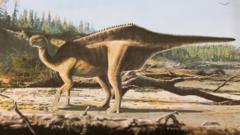Could a New Dinosaur Be Named After a Record-Breaking Sailor?

This article explores the recent discovery of a new dinosaur species, named Istiorachis macaruthurae, which features a striking sail along its back. Found on the Isle of Wight, this herbivore's name pays homage to renowned sailor Dame Ellen MacArthur, linking her legacy to a creature that existed 125 million years ago.
Last updated: 06 October 2023 (BST)
Key Takeaways
- The new dinosaur species is named Istiorachis macaruthurae, meaning "sail spine."
- Its discovery was made on the Isle of Wight, a significant site for dinosaur fossils.
- Dame Ellen MacArthur expressed her honour at having the dinosaur named after her.
- The species dates back approximately 125 million years.
- Its unique sail-like spine may have been used for display purposes.
Discovery of Istiorachis macaruthurae
The Isle of Wight has long been a treasure trove for palaeontologists, with its rich deposits offering insights into prehistoric life. The recent discovery of Istiorachis macaruthurae has added a remarkable new chapter to its history. Unearthed by fossil hunter Nick Chase, the remains of this medium-sized herbivore were initially misclassified. However, following a thorough analysis by island-based scientist Jeremy Lockwood, it has been recognised as a distinct species.
Name Origins and Significance
The name Istiorachis macaruthurae is derived from two components: "Istiorachis," which translates to "sail spine," and "macaruthurae," honouring Dame Ellen MacArthur. This connection not only highlights the uniqueness of the dinosaur but also reflects the personal significance to MacArthur, a record-breaking yachtswoman who sailed solo around the world.
MacArthur remarked on the honour of having a dinosaur named after her, noting the emotional link between the creature's sail-like structure and her own experiences with sails during her extensive sailing career. Her words encapsulate the extraordinary nature of this homage, bridging the vast gap of time from the dinosaur's existence to the present.
Fossil Analysis and Implications
Upon analysis, it became clear that the skeleton of Istiorachis macaruthurae was not as complete as some previously discovered specimens. However, its notably long neural spines set it apart from the other known iguanodontian species on the Isle of Wight. Dr Lockwood stated that previous assumptions had overlooked these distinctive features, which may have had a functional role in the dinosaur's behaviour.
The Role of the Sail
Dr Lockwood speculated that the sail-like structure could have been used for display purposes, similar to how peacocks use their feathers. The sail may have served to attract mates or intimidate rivals, suggesting a complex social behaviour among these dinosaurs. This aspect of their life is particularly fascinating, as it hints at a level of social interaction previously unconsidered in this group of dinosaurs.
Historical Context
The remains of Istiorachis macaruthurae date back to the Early Cretaceous period, roughly 125 million years ago. During this time, the landscape of what is now the Isle of Wight would have been vastly different, characterised by lush vegetation and thriving ecosystems. The region was likely a floodplain, providing a rich habitat for various dinosaur species.
Fossil Hunter Nick Chase
Nick Chase, who discovered the fossils, played a pivotal role in bringing attention to this area of the Isle of Wight. Sadly, he passed away in 2019, but his contributions to palaeontology continue to resonate. The discovery of Istiorachis macaruthurae stands as a testament to his legacy and dedication to the field.
Display at Dinosaur Isle Museum
Visitors to the Dinosaur Isle Museum in Sandown can now view the remains of Istiorachis macaruthurae, which have been officially classified and described. This exhibit not only showcases the dinosaur itself but also serves to educate the public about the rich prehistoric history of the Isle of Wight.
Significance of the Discovery
The naming of Istiorachis macaruthurae represents a significant advancement in our understanding of dinosaur diversity and evolution. The unique characteristics of this species shed light on the evolutionary adaptations that occurred during the Early Cretaceous. Furthermore, the connection to Dame Ellen MacArthur adds a contemporary narrative, bridging the gap between ancient history and modern achievements.
Future Research Directions
As research continues, palaeontologists are likely to explore the evolutionary implications of the sail-like structures found in Istiorachis macaruthurae. By comparing these features with other species, scientists can better understand the ecological roles of such adaptations. The ongoing study of fossils from the Isle of Wight promises to yield further discoveries that could reshape our knowledge of dinosaur behaviour and physiology.
Conclusion
The discovery of Istiorachis macaruthurae not only highlights the remarkable biodiversity of the Cretaceous period but also celebrates the connection between past and present. As we learn more about these ancient creatures, we gain deeper insights into the evolutionary processes that have shaped life on Earth. How many more secrets lie buried in the fossil record, waiting to be uncovered?
FAQs
What does the name Istiorachis macaruthurae mean?
Istiorachis macaruthurae means "sail spine," with "Istiorachis" referring to the dinosaur's sail-like back and "macaruthurae" honouring Dame Ellen MacArthur.
When did Istiorachis macaruthurae live?
Istiorachis macaruthurae lived approximately 125 million years ago during the Early Cretaceous period.
Where was this dinosaur discovered?
The remains of Istiorachis macaruthurae were discovered on the Isle of Wight, UK, a site known for its rich fossil deposits.
What role did the sail have in Istiorachis macaruthurae's life?
The sail may have been used for display purposes, potentially to attract mates or intimidate rivals, similar to the behaviour observed in modern animals like peacocks.
Who was Nick Chase?
Nick Chase was a fossil hunter who discovered the remains of Istiorachis macaruthurae. He passed away in 2019 but made significant contributions to palaeontology on the Isle of Wight.
Where can I see Istiorachis macaruthurae?
You can see the remains of Istiorachis macaruthurae at the Dinosaur Isle Museum in Sandown, Isle of Wight.
Published: 2025-08-22 11:18:04 | Category: technology



